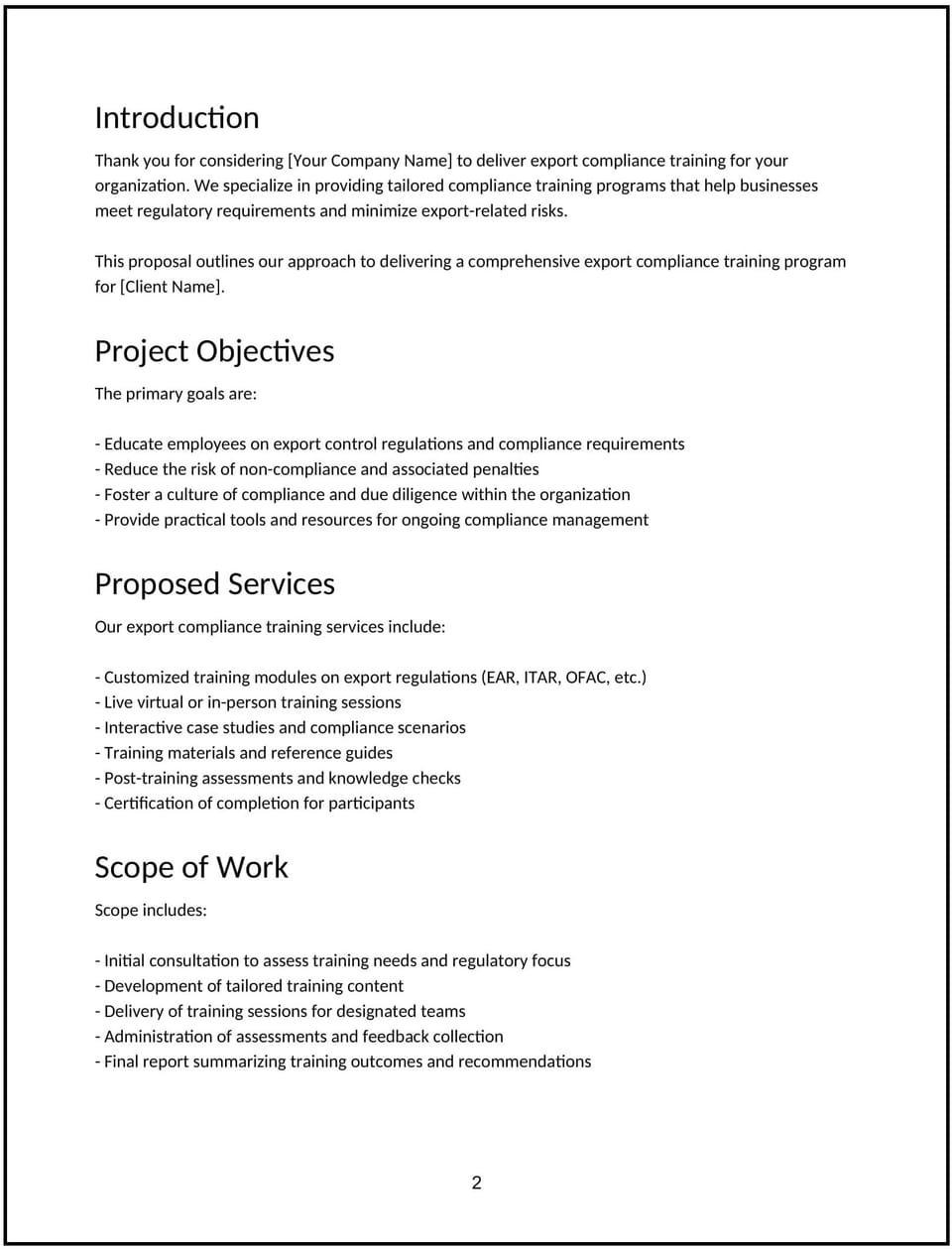Export compliance training proposal: Free template

Customize this free export compliance training proposal with Cobrief
Open this free export compliance training proposal in Cobrief and start editing it instantly using AI. You can adjust the tone, structure, and content based on your client’s industry, risk profile, and regulatory obligations. You can also use AI to review your draft — clarify unclear language, tighten delivery steps, and flag any missing details before sending.
Once you're done, send, download, or save the proposal in one click — no formatting or setup required.
This template is fully customizable and built for real-world use — ideal for manufacturers, SaaS providers, logistics firms, and any business that exports goods, services, or technology subject to U.S. or international trade controls. Whether you’re offering live training or on-demand modules, this proposal helps you define your scope clearly and build client confidence.
What is an export compliance training proposal?
An export compliance training proposal outlines how you’ll educate a client’s team on relevant trade regulations — including U.S. EAR, ITAR, OFAC sanctions, and other jurisdictional rules. It covers the scope of training, audience, delivery format, learning objectives, and pricing.
This proposal is commonly used by legal consultants, compliance trainers, and trade advisors offering onboarding or refresher training for regulated companies. It’s often used ahead of audits, onboarding new teams, or responding to internal compliance gaps.
Unlike general compliance or legal training proposals, this one is focused specifically on helping businesses understand and apply export control laws in their daily operations.
Why use Cobrief to edit your proposal
- Edit the full proposal instantly: No need for Word or PDF tools — just click and customize in-browser.
- Use AI to tailor your content: Adjust based on audience (legal, sales, ops) or the specific export regimes involved.
- Run a full AI-powered review: Catch unclear deliverables, missing training topics, or vague outcomes before sending.
- Apply edits in one click: Accept changes section-by-section or all at once.
- Save, send, or download: Export your final version instantly — ready to present to clients.
When to use this proposal
- When delivering in-house training on U.S. or international export control laws
- When responding to a client request following a compliance gap or audit finding
- When onboarding a new team or business unit involved in international operations
- When packaging export compliance support with broader legal or risk consulting services
- When supporting clients in regulated industries like aerospace, defense, semiconductors, or dual-use software
What to include in an export compliance training proposal
- Project overview: Summarize the purpose of the training — e.g., meeting audit requirements, reducing export risk, or educating internal teams. Tailor this based on the client’s operations and exposure.
- Scope of work: List the training services provided — such as content development, live sessions, recorded modules, quizzes, certificates of completion, and Q&A. Clarify whether training is role-specific (e.g., sales vs. ops) and whether it includes post-training support.
- Timeline: Provide a clear schedule — including kickoff, content finalization, training delivery, and follow-up. Include time for stakeholder review or customization, if applicable.
- Delivery format: Specify how the training will be delivered — live webinar, on-site session, LMS upload, or custom video modules. Include options for tracking attendance or issuing completion records.
- Pricing: Show the full cost — as a flat rate, per-session fee, or per-user license. Note whether updates, translations, or retainer access are included or optional.
- Call to action / next steps: Close with a clear prompt — approve the proposal, confirm delivery format, or book a kickoff call. Make it simple for the client to proceed.
How to write an effective export compliance training proposal
- Focus on business risk: Emphasize how training protects against fines, license violations, and reputational harm.
- Tailor content to roles: Show that different teams (e.g., engineers vs. sales) get relevant, specific guidance.
- Keep it digestible: Clients want to know training will be practical, not legalistic — highlight plain-English delivery and examples.
- Be clear on format: Spell out exactly how the training is delivered, recorded, and documented.
- Include measurable outcomes: Where possible, mention tests, certification, or internal audit-readiness results.
- Close with clarity: Help the client act quickly by ending with a confident next step.
Frequently asked questions (FAQs)
What regulations does this training cover?
The training can be tailored to include U.S. EAR, ITAR, OFAC sanctions, anti-boycott laws, and local equivalents. Just clarify what applies to the client based on their business and location.
Can I use this for remote or global teams?
Yes — the training can be delivered virtually, recorded for future use, or localized for global operations. Just note these options in the delivery section.
Does the proposal include post-training documentation?
Yes — if included in scope, you can provide attendance logs, certificates, or post-session summaries. Be sure to clarify what's included.
Can I combine this with a broader compliance program?
Absolutely. You can package training alongside policy development, risk audits, or export licensing support.
Does this proposal act as a legal agreement?
No — this outlines your services and pricing. A formal contract or engagement letter should follow if the client accepts.
This article contains general legal information and does not contain legal advice. Cobrief is not a law firm or a substitute for an attorney or law firm. The law is complex and changes often. For legal advice, please ask a lawyer.